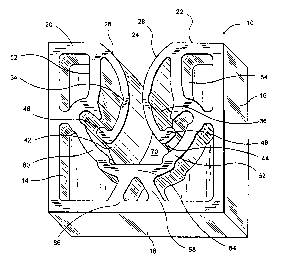Une partie des informations de ce site Web a été fournie par des sources externes. Le gouvernement du Canada n'assume aucune responsabilité concernant la précision, l'actualité ou la fiabilité des informations fournies par les sources externes. Les utilisateurs qui désirent employer cette information devraient consulter directement la source des informations. Le contenu fourni par les sources externes n'est pas assujetti aux exigences sur les langues officielles, la protection des renseignements personnels et l'accessibilité.
L'apparition de différences dans le texte et l'image des Revendications et de l'Abrégé dépend du moment auquel le document est publié. Les textes des Revendications et de l'Abrégé sont affichés :
| (12) Brevet: | (11) CA 2317192 |
|---|---|
| (54) Titre français: | CLIP AVEC BRAS DE VERROUILLAGE FLEXIBLES |
| (54) Titre anglais: | CLIP WITH FLEXIBLE LOCKING ARMS |
| Statut: | Périmé et au-delà du délai pour l’annulation |
| (51) Classification internationale des brevets (CIB): |
|
|---|---|
| (72) Inventeurs : |
|
| (73) Titulaires : |
|
| (71) Demandeurs : |
|
| (74) Agent: | FINLAYSON & SINGLEHURST |
| (74) Co-agent: | |
| (45) Délivré: | 2003-11-25 |
| (22) Date de dépôt: | 2000-08-31 |
| (41) Mise à la disponibilité du public: | 2001-04-18 |
| Requête d'examen: | 2000-08-31 |
| Licence disponible: | S.O. |
| Cédé au domaine public: | S.O. |
| (25) Langue des documents déposés: | Anglais |
| Traité de coopération en matière de brevets (PCT): | Non |
|---|
| (30) Données de priorité de la demande: | ||||||
|---|---|---|---|---|---|---|
|
The clip includes two locking arms with proximal segments
joining the outer periphery, distal segments forming a tube pocket,
and hinge elements between the proximal segments and the distal
segments. The distal segments include outwardly turned locking
elements. An interior frame joined to said outer periphery
includes locking pockets complementary to the locking elements. A
tube pocket is formed between the distal segments of the locking
arms and a portion of the interior frame. As the distal segments
of the locking areas flex outwardly in response to the insertion of
a tubular element, the outwardly turned locking elements are urged
into the locking pockets.
Note : Les revendications sont présentées dans la langue officielle dans laquelle elles ont été soumises.
Note : Les descriptions sont présentées dans la langue officielle dans laquelle elles ont été soumises.

2024-08-01 : Dans le cadre de la transition vers les Brevets de nouvelle génération (BNG), la base de données sur les brevets canadiens (BDBC) contient désormais un Historique d'événement plus détaillé, qui reproduit le Journal des événements de notre nouvelle solution interne.
Veuillez noter que les événements débutant par « Inactive : » se réfèrent à des événements qui ne sont plus utilisés dans notre nouvelle solution interne.
Pour une meilleure compréhension de l'état de la demande ou brevet qui figure sur cette page, la rubrique Mise en garde , et les descriptions de Brevet , Historique d'événement , Taxes périodiques et Historique des paiements devraient être consultées.
| Description | Date |
|---|---|
| Le délai pour l'annulation est expiré | 2005-08-31 |
| Lettre envoyée | 2004-08-31 |
| Accordé par délivrance | 2003-11-25 |
| Inactive : Page couverture publiée | 2003-11-24 |
| Inactive : Taxe finale reçue | 2003-09-03 |
| Préoctroi | 2003-09-03 |
| Un avis d'acceptation est envoyé | 2003-03-06 |
| Lettre envoyée | 2003-03-06 |
| Un avis d'acceptation est envoyé | 2003-03-06 |
| Inactive : Approuvée aux fins d'acceptation (AFA) | 2003-02-25 |
| Demande publiée (accessible au public) | 2001-04-18 |
| Inactive : Page couverture publiée | 2001-04-17 |
| Inactive : CIB attribuée | 2000-10-11 |
| Inactive : CIB en 1re position | 2000-10-11 |
| Inactive : Certificat de dépôt - RE (Anglais) | 2000-09-21 |
| Lettre envoyée | 2000-09-21 |
| Demande reçue - nationale ordinaire | 2000-09-20 |
| Exigences pour une requête d'examen - jugée conforme | 2000-08-31 |
| Toutes les exigences pour l'examen - jugée conforme | 2000-08-31 |
Il n'y a pas d'historique d'abandonnement
Le dernier paiement a été reçu le 2003-08-05
Avis : Si le paiement en totalité n'a pas été reçu au plus tard à la date indiquée, une taxe supplémentaire peut être imposée, soit une des taxes suivantes :
Les taxes sur les brevets sont ajustées au 1er janvier de chaque année. Les montants ci-dessus sont les montants actuels s'ils sont reçus au plus tard le 31 décembre de l'année en cours.
Veuillez vous référer à la page web des
taxes sur les brevets
de l'OPIC pour voir tous les montants actuels des taxes.
| Type de taxes | Anniversaire | Échéance | Date payée |
|---|---|---|---|
| Taxe pour le dépôt - générale | 2000-08-31 | ||
| Enregistrement d'un document | 2000-08-31 | ||
| Requête d'examen - générale | 2000-08-31 | ||
| TM (demande, 2e anniv.) - générale | 02 | 2002-09-02 | 2002-08-13 |
| TM (demande, 3e anniv.) - générale | 03 | 2003-09-01 | 2003-08-05 |
| Taxe finale - générale | 2003-09-03 |
Les titulaires actuels et antérieures au dossier sont affichés en ordre alphabétique.
| Titulaires actuels au dossier |
|---|
| ILLINOIS TOOL WORKS INC. |
| Titulaires antérieures au dossier |
|---|
| MARK J. KWILOSZ |